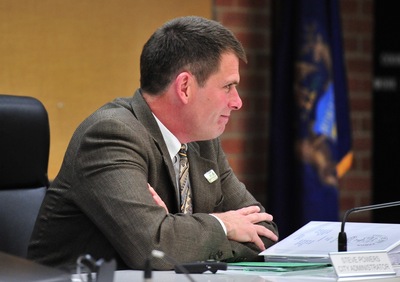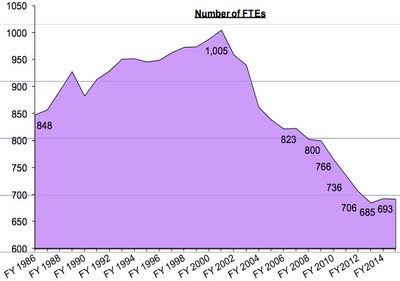City Administrator Steve Powers received a round of applause for the second year in a row after presenting his annual budget plan to the Ann Arbor City Council Monday night.
The city administrator's mostly status-quo budget, which now goes to council for potential changes and final approval in May, shows the city's general fund revenues rising from $79.2 million to $82.6 million as the city heads into the 2013-14 fiscal year starting July 1.
"Your policy discipline over the past 10 years has really contributed to the city's sound financial position," Powers told council members.

City Administrator Steve Powers said his budget plan addresses some deferred maintenance items the city has put off over the past several years.
Ryan J. Stanton | AnnArbor.com
Powers pointed out that, just looking at the revenues and expenditures labeled as "recurring," there's a $1.35 million surplus shown in the budget for next year. But his budget also proposes $1.6 million in one-time costs, using up that surplus and then some.
"While the financial forecast for the city is improving, the recommended budget does urge spending restraint and prudent financial decisions," Powers said.
"Recurring expenditures are funded by recurring revenues, so the balanced budget is not creating difficulties for the city and difficulties for council in later years."
Powers said his budget plan addresses some deferred maintenance items the city has put off over the past several years.
Some of the budget notes he highlighted include $60,000 for increased costs of painting and replacing streetlight poles, $269,000 for regulatory-related items and capital improvements at Barton and Superior Dams, $138,000 in increased revenues based on building and planning activity, and $20,000 to do a citizen survey to measure public perception of services.
Powers' budget also includes putting $234,000 into the police department for increased overtime and funding for county animal control.
The administrator presented a two-year budget plan that shows the city digging deeper into its reserves to pay for more one-time costs in the 2014-15 fiscal year.
In the second year of the two-year plan, recurring revenues and expenditures are generally balanced at $84 million, but then another $1.6 million in one-time costs are shown.
Tapping the general fund reserves to pay for $3.2 million worth of non-recurring cost items over the next two years would reduce the fund balance to 14.4 percent of expenditures.
Tom Crawford, the city's chief financial officer, in the past has recommended the City Council maintain a fund balance equal to 15 to 20 percent of expenditures.

The city has slashed roughly a third of its workforce over the past decade or so.
City of Ann Arbor
"We are seeing some good news on the revenue side," Powers said. "The proposed budget is actually in a position where I am recommending that the total city millage actually decrease by 0.125 mills."
With the local and state economy improving, the city predicts property tax revenues will climb by 2.3 percent next year — even with the planned 0.125-mill decrease in the city's tax rate.
The reduction in the tax rate offsets the increase the city saw from the new 0.125-mill sidewalk millage approved by voters in 2011. That translates to about $13 a year for the average homeowner.
Water and sewer rates on average are projected to increase 3.7 percent to help pay for maintenance and upgrades at the water and wastewater treatment plants. There'll be separate public hearings on the utility rate increases and the overall city budget on May 6.
Powers said the policy direction council has established over the years is resulting in some significant containment of employee costs on health insurance and pensions, with employees contributing more than they had in the past. Employees now put 6 percent of their pay toward pension costs.
The 693 full-time employees Powers is recommending in the city budget for next year is up 7.67 FTEs from the approved 2012-13 budget, but six of those essentially already have been approved. Four are additional firefighters the city hired within the past year, and two are building development inspectors the city hired within the past year to reduce the wait time for construction projects.
One new position being created is in the IT department where the city has decided to hire a full-time employee to replace contracted services, and the remaining 0.67 FTE is in accounting.
The City Council is expected to deliberate on the budget, consider amendments and take a final vote at its May 20 meeting. It's expected council members will consider whether to increase police and fire staffing and restore some services like fall leaf pickup an holiday tree pickup.
Police Chief John Seto said at a budget work session last month Ann Arbor has inadequate police staffing resources to do proactive and consistent enforcement and community outreach. Similar concerns have been expressed about the fire department's ability to respond to fires.
Council members didn't comment on the administrator's budget plan Monday night, but Mayor John Hieftje offered his thanks to Powers for "that good message."
"Now the hard choices are yours," Powers told council members.
The administrator's budget plan cautions early projections show the city could face deficits in future years. Recurring expenditures are projected to be $859,822 higher than revenues in 2015-16, and $1.6 million higher than revenues in 2016-17 — before thinking about any one-time costs.
Ryan J. Stanton covers government and politics for AnnArbor.com. Reach him at ryanstanton@annarbor.com or 734-623-2529. You also can follow him on Twitter or subscribe to AnnArbor.com's email newsletters.